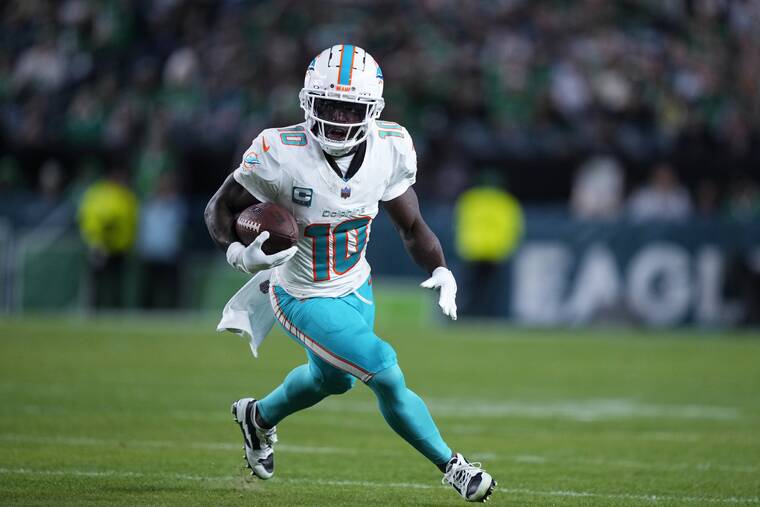The Dolphins’ utilization of ‘cheat motion’ takes the NFL by storm
SANTA CLARA, Calif. (AP) — Coach Kyle Shanahan saw the new wrinkle his former assistant Mike McDaniel added to the Miami offense by putting speedster Tyreek Hill in short motion at the snap and immediately added it to the San Francisco offense.
The opportunity to give a playmaker a running start was just the type of addition Shanahan wanted for Deebo Samuel and other playmakers on the 49ers offense so he added it his own playbook with the name “cheat motion.”
ADVERTISING
Why that name?
“I don’t know. It looks hard to stop people like Tyreek and Deebo and stuff with a running start,” Shanahan said. “That’s usually only in the CFL. So it’s cool to get them running sideways and still find a way to hit it vertically.”
The use of pre-snap motion has been on the rise throughout the NFL over the past decade, going from a usage rate of just 37.5% of plays in 2014 to 54.6% so far this season, according to Sportradar.
Some of the most proficient and innovative offenses are using it an even higher rate, with McDaniel’s Dolphins running motion on a league-high 86.3% of plays, followed by the 78.4% for Shanahan’s 49ers, 71.6% for Andy Reid’s defending-champion Chiefs and 70.1% for Sean McVay’s Rams.
“It’s like a copycat league man,” Denver cornerback Patrick Surtain II said. “Offenses, they run the same type of concepts in different ways, though. So I just say communication is key, being on the same page. Because you know, once you are not on the same page, things get out of sorts and that’s when things start to break away and explosives come.”
That’s exactly what the Dolphins have done, best evidenced by the 70 points they scored against Surtain’s Broncos in Week 3 when they gained 726 yards on 71 plays.
Miami has been unbelievably effective. The Dolphins average 8.1 yards per play when using pre-snap motion as it has helped Tua Tagovailoa get the ball to his playmakers with more space to operate.
“I love the diversification of the motions, how it can set up so many different things,” fullback Alec Ingold said. “All of us are in motion pretty much all the time, so I love being a part of that. … I think it’s a big part of our offense and I love the fact that we can do that and execute while you’re moving full speed, side to side and then stretch a team vertically as well.”
McDaniel said it took time to get his players used to the system as last year the team was plagued by 38 pre-snap penalties on offense in part because of all the moving parts.
This season, the rate has been cut down with only 10 pre-snap penalties in their first seven games, with four coming in a loss on Sunday at Philadelphia.
“When it becomes your norm, guys kind of get uncomfortable now when there isn’t a motion on a play,” McDaniel said.
“They’re like, ‘where’s the rest of the play?’ But that takes a total commitment of everyone, including the offensive line, because you have to get used to the different types of snap counts that Tua uses to not only execute some of those motions, but then make sure that the defensive line can’t tee off on snap points, and then have variations of cadence on that, too. So everybody plays a part in it and it’s something that takes a village to execute.”
Teams have long used motion to help the quarterback determine whether the defense is in man or zone coverage based on whether a defender follows the player across the formation.
The motion players often re-set in those plays but the Dolphins prefer to snap with the motion player on the move, often with the “cheat” motion. Instead of sending a fast player like Tyreek Hill sprinting across the field before the snap, the Dolphins have him moving a much shorter distance on one side of the field.
While NFL rules don’t allow a player to be moving forward at the snap like in the Canadian Football League, even that short motion allows a player like Hill to hit his top speed even sooner and race past defenders who are more flat-footed.
Miami has run a league-high 77% of its plays with a player in motion at the snap, according to data from TruMedia and PFF. The Dolphins have scored 27 of their 31 offensive touchdowns with a player moving at the snap.



